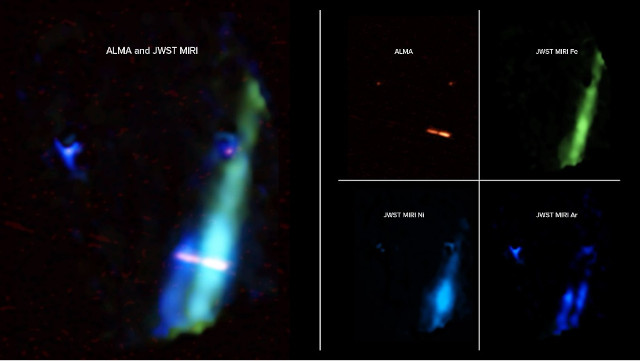
At the 244th Meeting of the American Astronomical Society, a study was presented of what turned out to be a pair of stars inside the WL20 group, cataloged as WL20S. The authors of this study combined observations conducted with the ALMA radio telescope and the James Webb Space Telescope to obtain the information necessary to establish that in that system there are two young stars, and not one as astronomers thought, which formed between 2 and 4 million years ago. Both stars are surrounded by disks of materials in which there could be planets forming and parallel jets of materials emitted by the two stars.
The top image (U.S. NSF/ NSF/ ALMA (ESO/NAOJ/NRAO)/ NASA/ JPL/ JWST/ B. Saxton.) shows the WL20S system in a combination of ALMA and Webb observations, with separate observations in the insets of ALMA, which shows the two circumstellar disks, and Webb’s MIRI instrument, which shows the jets of material.
The WL20 group is part of the larger Rho Ophiuchi complex, a relatively close-to-Earth molecular cloud, being a little more than 400 light-years from Earth. The consequence is that it’s the subject of many studies about star formation processes. The young stars of WL20 have been known since the 1970s but instrumental limitations prevented from seeing their details. The blanket of gas and dust in WL20 blocks many electromagnetic frequencies, so it’s necessary to use powerful instruments capable of detecting the ones that reach the Earth, which means infrared and radio waves.
The ALMA radio telescope made it possible to identify the two disks of materials in the WL20S system by detecting their radio emissions. The James Webb Space Telescope’s Mid-Infrared Instrument (MIRI) made it possible to identify jets of materials coming from the poles of the stars by detecting their infrared emissions.
The combination of the observations offered by the two instruments was the key to understanding that it’s a binary system. That’s because ALMA’s observations could be interpreted as a single disk with a gap within it. MIRI has sufficient spatial and spectral resolution to see the jets and obtain the information needed to understand the structure of the WL20S system. Spectroscopic analyzes also offer information on the chemical composition of the disks and jets.
The presence of the jets of material indicates that the stars are very young, with an age that was estimated between 2 and 4 million years. However, the materials from the original cloud from which the stars were born were absorbed, indicating that the formation of the system is at an advanced stage. The beginning of planet formation may already be underway in the circumstellar disks, and this makes the WL20S system even more interesting.
WL20S is a system that adds to the others known in their formation phase. Upgrades to the ALMA radio telescope systems are scheduled which will make it even more powerful and sensitive, offering the possibility of detecting other details of systems such as WL20S.
The bottom image (U.S. NSF/ NSF NRAO/B. Saxton.; NASA/JPL-Caltech/Harvard-Smithsonian CfA) shows the WL20 star group on the left and an artist’s impression of the WL20S system on the right.


